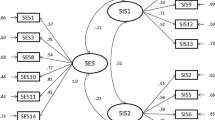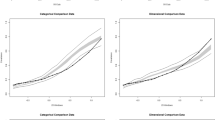Abstract
For the last three decades, male and female sexual responses have been conceptualized as similar, based on separated and sequential phases as proposed by the models of Masters and Johnson (1966) and Kaplan (1979) model. However, there is a growing debate around the need to conceptualize female sexual response and the classification of sexual dysfunction in women, in view of the upcoming editions of the DSM and ICD. The aim of this study was to test, using structural equation modeling, five conceptual, alternative models of female sexual function, using a sample of women with sexual difficulties and a sample of women without sexual problems. A total of 1993 Portuguese women participated in the study and completed a modified version of the Female Sexual Function Index. Findings suggested a four-factor solution as the model that best fit the data regarding women presenting sexual difficulties: (1) desire/arousal; (2) lubrication; (3) orgasm; (4) pain/vaginismus. In relation to sexually healthy women, the best model was a five-factor solution comprising of (1) desire; (2) arousal; (3) lubrication; (4) orgasm; and (5) pain/vaginismus. Discriminant validity between factors was supported, suggesting that these dimensions measure distinct phenomena. Model fit to the data significantly decreased in both samples, as models began to successively consider greater levels of overlap among phases of sexual function, towards a single-factor solution. By suggesting the overlap between pain and vaginismus, results partially support the new classification that is currently being discussed regarding DSM-5. Additionally, results on the relationship between sexual desire and arousal were inconclusive as sexually healthy women were better characterized by a five-factor model that considered the structural independence among these factors, whereas women with sexual difficulties better fit with a four-factor model merging sexual desire and subjective sexual arousal.
Similar content being viewed by others
References
American Psychiatric Association. (1968). Diagnostic and statistical manual of mental disorders (2nd ed.). Washington, DC: Author.
American Psychiatric Association. (1980). Diagnostic and statistical manual of mental disorders (3rd ed.). Washington, DC: Author.
American Psychiatric Association. (2000). Diagnostic and statistical manual of mental disorders (4th ed.). Washington, DC: Author.
Balon, R., Segraves, R. T., & Clayton, A. (2007). Issues for DSM-V: Sexual dysfunction, disorder, or variation along normal distribution: Toward rethinking DSM criteria of sexual dysfunctions. American Journal of Psychiatry, 164, 198–200.
Bancroft, J., Loftus, J., & Long, S. (2003). Distress about sex: A national survey of women in heterosexual relationships. Archives of Sexual Behavior, 32, 193–208.
Basson, R. (2001a). Human sex-response cycles. Journal of Sex and Marital Therapy, 27, 33–43.
Basson, R. (2001b). Using a different model for female sexual response to address women’s problematic low sexual desire. Journal of Sex and Marital Therapy, 27, 395–403.
Basson, R. (2002). A model of women’s sexual arousal. Journal of Sex and Marital Therapy, 28, 1–10.
Basson, R. (2003). Biopsychosocial models of women’s sexual response: Applications to management of “desire disorders”. Sexual and Relationship Therapy, 18, 107–115.
Basson, R., Althof, S., Davis, S., Fugl-Meyer, K., Goldstein, I., Leiblum, S.,... Wagner, G. (2003a). Summary of the recommendations on sexual dysfunctions in women. Journal of Sexual Medicine, 1, 24–34.
Basson, R., Berman, J., Burnett, A., Degoratis, L., Fergunson, D., Fourcroy, J.,... Whipple, B. (2001). Report of the international consensus development conference on female sexual dysfunctions: Definitions and classifications. Journal of Sex and Marital Therapy, 27, 83–94.
Basson, R., Leiblum, S., Brotto, L., Degoratis, L., Fourcroy, J., Fugl-Meyer, K.,... Schultz, W. W. (2003b). Definitions of women’s sexual dysfunction reconsidered: Advocating expiation and revision. Journal of Psychosomatic Obstetrics and Gynaecology, 24, 221–229.
Basson, R., & Schultz, W. (2007). Sexual sequelae of general medical disorders. Lancet, 369, 409–429.
Baumgartner, H., & Homburg, C. (1996). Applications of structural equation modeling in marketing and consumer research: A review. International Journal of Research in Marketing, 13, 139–161.
Binik, Y. M. (2005a). Should dyspareunia be retained as a sexual dysfunction in DSM-V? A painful classification decision. Archives of Sexual Behavior, 34, 11–21.
Binik, Y. M. (2005b). Dyspareunia looks sexy on first but how much pain will it take for it to score? A reply to my critics concerning the DSM classification of dyspareunia as a sexual dysfunction. Archives of Sexual Behavior, 34, 63–67.
Binik, Y. M. (2010a). The DSM diagnostic criteria for vaginismus. Archives of Sexual Behavior, 39, 278–291.
Binik, Y. M. (2010b). The DSM diagnostic criteria for dyspareunia. Archives of Sexual Behavior, 39, 292–303.
Binik, Y. M., Reissing, E., Pukall, C., Flory, N., Payne, K. A., & Khalifé, S. (2002). The female sexual pain disorders: Genital pain or sexual dysfunction? Archives of Sexual Behavior, 31, 425–429.
Brotto, L. A. (2010a). The DSM diagnostic criteria for hypoactive sexual desire disorder in women. Archives of Sexual Behavior, 39, 221–239.
Brotto, L. A. (2010b). The DSM diagnostic criteria for sexual aversion disorder. Archives of Sexual Behavior, 39, 271–277.
Brotto, L. A., Graham, C. A., Binik, Y. M., Segraves, R. T., & Zucker, K. J. (2011). Should sexual desire and arousal disorders in women be merged? A response to Derogatis, Clayton, Rosen, Sand, and Pyke (2010) [Letter to the Editor]. Archives of Sexual Behavior, 40, 221–225.
Brotto, L. A., Heiman, J. R., & Tolman, D. L. (2009). Narratives of desire in mid-age women with and without arousal difficulties. Journal of Sex Research, 46, 387–398.
Browne, M. W., & Cudeck, R. (1993). Alternative ways of assessing model fit. In K. A. Bollen & J. S. Long (Eds.), Testing structural equation models (pp. 136–162). Beverly Hills, CA: Sage.
Chivers, M. L., & Bailey, J. M. (2005). A sex difference in features that elicit genital response. Biological Psychology, 70, 115–120.
Chivers, M. L., Seto, M. C., Lalumière, M. L., Laan, E., & Grimbos, T. (2010). Agreement of self-reported and genital measures of sexual arousal in men and women: A meta-analysis. Archives of Sexual Behavior, 39, 5–56.
Cote, J., Netemeyer, R., & Bentler, P. (2001). Structural equations modeling: Improving model fit by correlating errors. Journal of Consumer Psychology, 10, 87–88.
Cyranowski, J. M., Bromberger, J., Youk, A., Mathews, K., Kravitz, H. M., & Powel, L. H. (2004). Lifetime depression history and sexual function in women at midlife. Archives of Sexual Behavior, 33, 539–548.
DeRogatis, L. R., Clayton, A. H., Rosen, R. C., Sand, M., & Pyke, R. E. (2011). Should sexual desire and arousal disorders in women be merged? [Letter to the Editor]. Archives of Sexual Behavior, 40, 217–219.
Diamantopoulos, A., & Siguaw, J. A. (2000). Introducing LISREL. London: Sage.
Graham, C. A. (2010). The DSM diagnostic criteria for female sexual arousal disorder. Archives of Sexual Behavior, 39, 240–255.
Hair, J., Anderson, R., Tatham, R., & Black, W. (1998). Multivariate data analysis (5th ed.). London: Prentice Hall International.
Hartmann, U., Heiser, K., Ruffer-Hesse, C., & Kloth, G. (2002). Female sexual desire disorders: Subtypes, classifications, personality factors and new directions for treatment. World Journal of Urology, 20, 79–88.
Hatzimouratidis, K., & Hatzichristou, D. (2007). Sexual dysfunctions: Classifications and definitions. Journal of Sexual Medicine, 4, 241–250.
Hill, C. A., & Preston, L. K. (1996). Individual differences in the experience of sexual motivation: Theory and measurement of dispositional sexual motives. Journal of Sex Research, 33, 27–45.
Jöreskog, K. G. (1993). Testing structural equation models. In K. A. Bollen & J. S. Long (Eds.), Testing structural equation models (pp. 294–316). Newbury Park, CA: Sage.
Jöreskorg, K. G., & Sörbom, D. (1993). LISREL 8: Structural equation modeling with the SIMPLIS command language. Lincolnwood, IL: Scientific Software International.
Kaplan, H. S. (1979). Disorders of sexual desire. New York: Brunner/Mazel.
Kuile, M. T., Brauer, M., & Laan, E. (2006). The Female Sexual Function Index (FSFI) and the Female Sexual Distress Scale (FSDS): Psychometric properties within a Dutch population. Journal of Sex and Marital Therapy, 32, 289–304.
Laan, E., & Everaerd, W. (1995). Determinants of female sexual arousal: Psychophysiological theory and data. Annual Review of Sex Research, 6, 32–76.
Laumann, E. O., Paik, A., & Rosen, R. C. (1999). Sexual dysfunction in the United States: Prevalence and predictors. Journal of the American Medical Association, 281, 537–544.
Levin, R. J., & van Berlo, W. (2004). Sexual arousal and orgasm in subjects who experience forced or non-consensual sexual stimulation—A review. Journal of Clinical Forensic Medicine, 11, 82–88.
MacCallum, R. C., Browne, M. W., & Sugawara, H. M. (1996). Power analysis and determination of sample size for covariance structure modeling. Psychological Methods, 1, 130–149.
Masters, W. H., & Johnson, V. E. (1966). Human sexual response. Boston: Little, Brown.
Meana, M. (2010). Elucidating women’s (hetero)sexual desire: Definitional challenges and content expansion. Journal of Sex Research, 47, 104–122.
Meston, C. M. (2000). The psychophysiological assessment of female sexual function. Journal of Sex Education and Therapy, 25, 6–16.
National Institute of Statistics. (2002). Census 2001: Definitive results. Lisbon: Author.
Nobre, P. J., & Pinto-Gouveia, J. (2008). Cognitive and emotional predictors of female sexual dysfunctions: Preliminary findings. Journal of Sex and Marital Therapy, 34, 325–342.
Pechorro, P., Diniz, A., Almeida, S., & Vieira, R. (2009). Validação portuguesa do índice de funcionamento sexual feminino. Laboratório de Psicologia, 7, 33–44.
Pfaus, J. G. (2009). Pathways of sexual desire. Journal of Sexual Medicine, 6, 1506–1533.
Ping, R. A. (2004). On assuring valid measures for theoretical models using survey data. Journal of Business Research, 57, 125–141.
Prause, N., Janssen, E., & Hetrick, W. P. (2008). Attention and emotional responses to sexual stimuli and their relationship to sexual desire. Archives of Sexual Behavior, 37, 934–949.
Regan, P. C., & Berscheid, E. (1999). Lust: What we know about human sexual desire. Thousand Oaks, CA: Sage.
Reissing, E. D., Binik, Y. M., Khalifé, S., Cohen, D., & Amsel, R. (2004). Vaginal spasm pain, and behavior: An empirical investigation of the diagnosis of vaginismus. Archives of Sexual Behavior, 33, 5–17.
Rosen, R., Brown, C., Heiman, J., Leiblum, S., Meston, C., Shabsigh, R.,... D’Agostino, R. (2000). The Female Sexual Function Index (FSFI): A multidimensional self-report instrument for the assessment of female sexual function. Journal of Sex and Marital Therapy, 26, 191–208.
Sand, M., & Fisher, W. A. (2007). Women’s endorsement of models of female sexual response: The Nurses’ Sexuality Study. Journal of Sexual Medicine, 4, 708–719.
Schultz, W. W., Basson, R., Binik, Y., Eschenbach, D., Wesselmann, U., & Lankveld, J. (2005). Women’s sexual pain and its management. Journal of Sexual Medicine, 2, 301–316.
Sidi, H., Abdullah, N., Puteh, S., & Midin, M. (2007). The Female Sexual Function Index (FSFI): Validation of the Malay version. Journal of Sexual Medicine, 4, 1642–1654.
Sidi, H., Naing, L., Midin, M., & Jaafar, N. (2008). The female sexual response cycle: Do Malaysian women conform to the circular model? Journal of Sexual Medicine, 5, 2359–2366.
Steenkamp, J., & van Trijp, H. (1991). The use of LISREL in validating marketing constructs. International Journal of Research in Marketing, 8, 283–299.
Tiefer, L., Hall, M., & Travis, C. (2002). Beyond dysfunction: A new view os women’s sexual problems. Journal of Sex and Marital Therapy, 28, 225–232.
Toates, F. (2009). An integrative theoretical framework for understanding sexual motivation, arousal, and behavior. Journal of Sex Research, 46, 168–193.
Verit, F. F., & Verit, A. (2007). Validation of the Female Sexual Function Index in women with chronic pelvic pain. Journal of Sexual Medicine, 4, 1635–1641.
Wiegel, M., Meston, C., & Rosen, R. (2005). The Female Sexual Function Index (FSFI): Cross-validation and development of clinical cutoff scores. Journal of Sex and Marital Therapy, 31, 1–20.
Williams, L. J., & Holahan, J. (1994). Parsimony-based fit indices for multiple-indicator models: Do they work? Structural Equation Modeling, 1, 161–189.
Witting, K., Santtila, P., Jern, P., Varjonen, M., Wager, I., Höglung, M., et al. (2008). Evaluation of the Female Sexual Function Index in a population based sample from Finland. Archives of Sexual Behavior, 37, 912–924.
World Health Organization. (1992). International statistical classification of diseases and related health problems. Geneva: Author.
Author information
Authors and Affiliations
Corresponding author
Appendix
Appendix
See Table 7.
Rights and permissions
About this article
Cite this article
Carvalho, J., Vieira, A.L. & Nobre, P. Latent Structures of Female Sexual Functioning. Arch Sex Behav 41, 907–917 (2012). https://doi.org/10.1007/s10508-011-9865-7
Received:
Revised:
Accepted:
Published:
Issue Date:
DOI: https://doi.org/10.1007/s10508-011-9865-7




